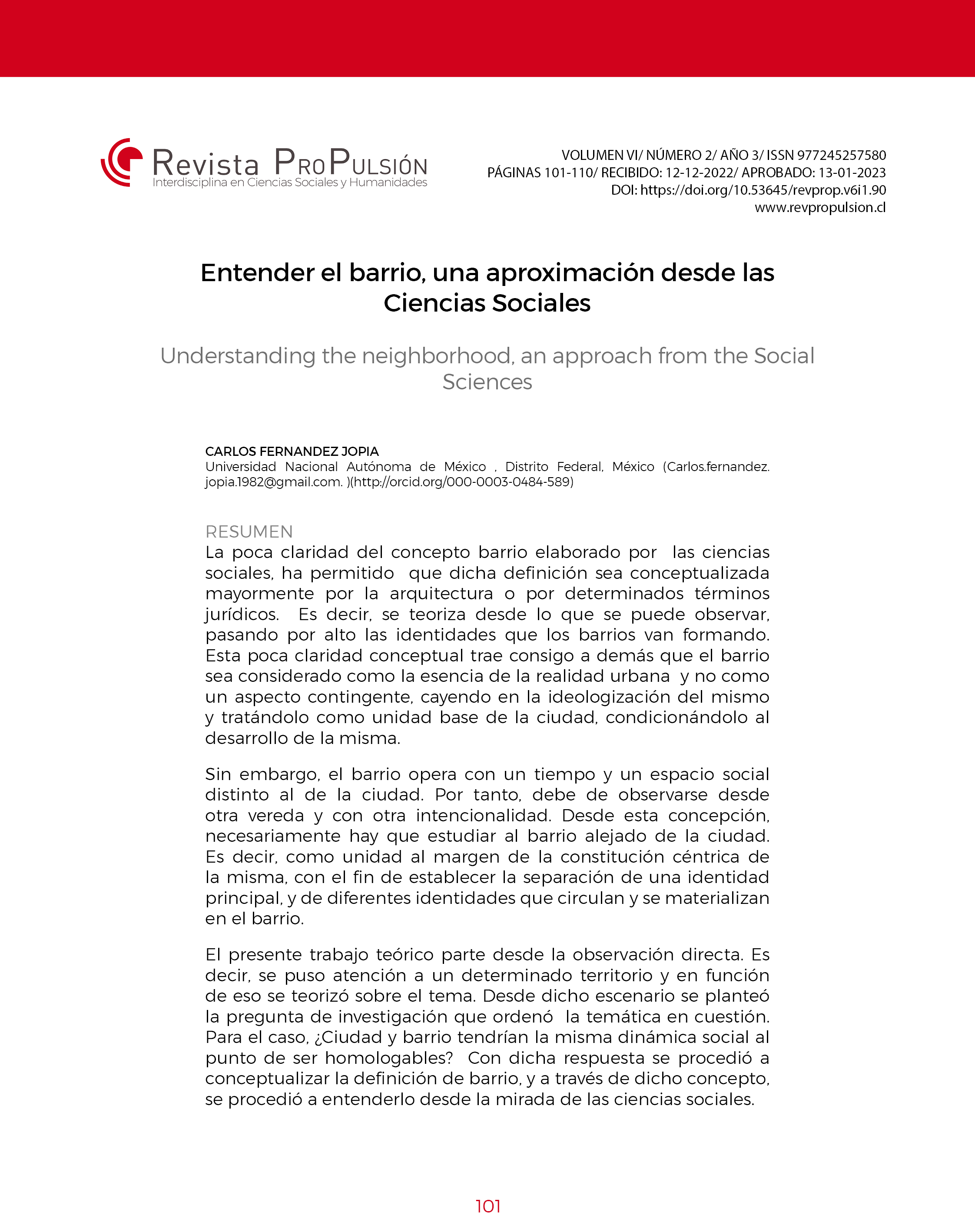Entender el barrio, una aproximación desde las ciencias sociales
DOI:
https://doi.org/10.53645/revprop.v6i1.90Keywords:
Barrio – identidad – ciudad – espacio social – ciencias socialesAbstract
The lack of clarity of the neighborhood concept elaborated by the social sciences has allowed this definition to be conceptualized mainly by architecture or by certain legal terms. That is to say, it´s theorized from what can be observed, ignoring the identities that the neighborhoods creates. Also, this lack of clarity brings with it the fact that the neighborhood is considered as the essence of urban reality and not as a contingent aspect, falling into the ideologization of it and treating it as the base unit of the city, conditioning it to its development.
However, the neighborhood operates with a different time and social space than the city. Therefore, it must be observed from another path and with another intention. From this conception, it is necessary to study the neighborhood far from the city. That is, as a unit outside it´s central constitution, in order to establish the separation of a main identity, and of different identities that circulate and materialize in the neighborhood.
Downloads
References
Augé, M. (1992). Los no lugares. Espacios del anonimato. Barcelona: Gesida.
Arturo O, José Antonio M. y Martín M.(2016) Plan de desarrollo comunal: ¿El instrumento rector de la gestión municipal en Chile? Revista INVI vol.31 no.87 Santiago ago. 2016
Bonavitta, P. (2012). Las ciudades de los excluidos en una Latinoamérica posmoderna. KAIROS.
Bourdieu, P. (1999). Meditaciones pascalianas. Barcelona: Anagrama S.A.
Castells, M. (1988). Problemas de investigacion en Sociologia Urbana. Mexico: siglo XXI.
Campo Tejedor, Alberto (2002). Investigar y deconstruir el estigma en barrios marginales. Un estudio de caso. BIBLID [1137-439X (2003), 24; 803-817]
Douglass, W. (1973). Muerte en murélaga. Barcelona: Barral.
Foucault, M. (2004). Vigilar y castigar. Nacimiento de la prisión. Mexico: Siglo XXI.
Galster, G. (2001). Sobre la naturaleza del vecindario . SAGE Estudios Urbanos , 2111-2124.
Gravao, A. (2008). Imaginarios barriales y gestion social. IX congreso de antropologia social , (págs. 1-12). posada, misiones.
Hernandez de Padrón, María Inés (2006). La pobreza urbana, organizaciones de barrio y las
redes de solidaridad locales Fermentum. Revista Venezolana de Sociología y Antropología, vol. 16, núm. 45
Lefebvre, H. (1975). De lo rural a lo Urbano. Barcelona: Peninsula.
Montero y Salas. (1993). Imagen, representación e ideología. El mundo visto desde la periferia.
Revista Latinoamericana de Psicología 25, 85-103.
Papalina, V. (2007). La ciudad latinoamericana como espacio multicultural: posibilidades para Revista Miradas de la UN de C.
Park, R. (1984). The City. Suggestions for Inves-tigation of Human Behavior in the Urban Enviroment. chicago: The University of Chicago Press.
Programa Quiero mi Barrio https://quieromibarrio.cl/index.php/publicaciones/libros- publicados/
Tapia, V. (2015). ¿de que hablamos cuando hablamos de barrio? trayectoria del concepto de
barrio y apuntes para su problematizacion. revista antropologias del sur N°3, 121-135.

Published
How to Cite
Issue
Section
Categories
License
Copyright (c) 2023 CARLOS FERNANDEZ

This work is licensed under a Creative Commons Attribution-NonCommercial 4.0 International License.
- Esta licencia permite a los reutilizadores distribuir, remezclar, adaptar y construir sobre el material en cualquier medio o formato solo con fines no comerciales, y solo mientras se dé atribución al creador.Incluye los siguientes elementos: POR – Se debe dar crédito al creador NC – Solo se permiten usos no comerciales de la obra.







